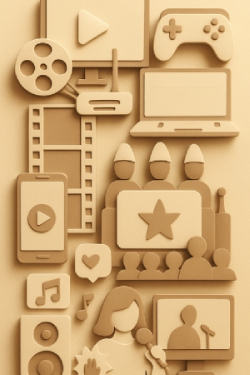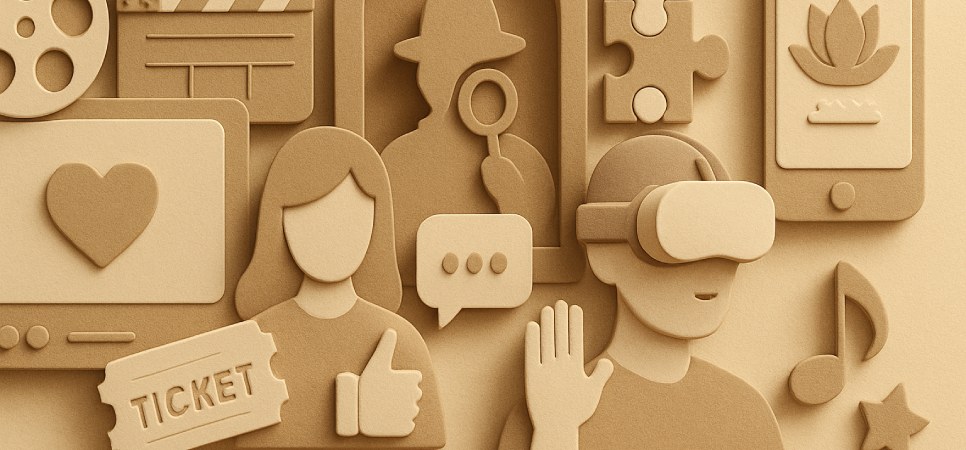
A single click after sundown can launch a film premiere, a live gig, and a ten-player co-op match within minutes; modern leisure resembles a fast-shifting quilt rather than a curated schedule. Viewers hardly pause to notice the handoff between mediums. Screens trade places with headsets, chat windows with ticket screens. A scroll of the thumb keeps everything in motion and rarely looks back.
Introduction to Modern Entertainment
Scholars often argue that convergence theory best describes this moment. Devices, platforms, and audiences combine in real time, producing a shared arena where cinema, radio-style podcasts, and online play coexist. No single format dictates terms. Instead, audiences sample, algorithms suggest, and communities critique. The outcome feels provisional, yet the pace of iteration suggests an enduring pattern.
Streaming and Social Video Trends
Short clips hold disproportionate power, compelling longer stories toward a style. When a live-action remake or courtroom comedy creates a viral response, subscription platforms act swiftly, flipping marketing budgets or release windows. Though this responsiveness can maximize engagement, it demonstrates how content supply now reacts to demand articulated in likes and stitches instead of overnight viewing.
Movies and TV Popular Events
Fan screenings, once written off as a niche fad, now serve as pre-emptive indicators of success. Studios project rough cut material or concept teasers and gauge applause, silence, or boos in seconds. Where applause does not always translate into profit, few executives can dismiss the direct message that a theater full of fan-costumed enthusiasts can give. Public peer-review, some producers argue, cuts risk before budgets run amok.
Music and Virtual Concerts
Online gigs raise familiar questions about authenticity, yet ticket sales remain healthy. A performer may not feel the sweat of stage lights, but the chat feed scrolls quicker than any physical crowd can roar. Merchandise drops prove lucrative; virtual photo booths extend the show; limited-edition emotes replace lighters waved during a ballad. Purists raise eyebrows. Accountants smile.
Gaming and Social Play
Competitive titles continue to dominate headlines; nevertheless, cooperative farming sims and craft-heavy survival worlds now attract similar user hours. Researchers attribute this shift to pandemic-era social habits that lingered. Players treat virtual plots of land or woodworking benches as informal meeting rooms. Voice chat covers daily anecdotes while avatars harvest wheat or sand down oak.
Virtual Reality and Mixed Reality
Hardware adoption has grown incrementally rather than explosively. Price and comfort barriers persist, but content libraries inch forward. Mixed reality, merging projected visuals with coffee tables and walls, offers a gentler entry route. Designers emphasise seated modes and shorter sessions, signalling awareness of fatigue issues that early evangelists perhaps underestimated.
AI And Personalized Content
Recommendation engines, refined through reinforcement loops, no longer settle for predicting preferences. Some platforms test dynamic trailers that rearrange clips mid-stream to align with real-time viewer feedback. Such adaptive editing blurs the boundary between promotion and production, inviting debate over authorship and the ethics of bespoke persuasion.

Nostalgia and Creator Content
Reboots appeal to a hunger for comfort familiarity, but influencer-driven formats inject new energy. When a popular video blogger hosts a reality competition, viewers come pre-organized, ready to support or criticize. Traditional casting directors, who were once gatekeepers, now share territory with social-media talent spotters. The resulting productions rarely fit new genre categories neatly.
Immersive Theatre and Experiences
Pop-up adventures turn warehouses into detective stories or time-traveling quests. Guests decode secret codes, bargain with performers, or earn digital badges tied to blockchain proofs of presence. Whether the scholarly merit of such badges is questionable, the feeling of validated remembrance is not. Experiential design is thus both storytelling art and logistical challenge.
Emerging VR Music Wellness Apps
Health researchers approach singing and deep-breathing exercises that place participants in reactive worlds with caution. Early research shows advantages on par with conventional mindfulness exercises. Low-pressure training is described by practitioners: lost notes cause gentle colour changes instead of jarring error buzzers. The hobby-therapy divide remains permeable but promising.
Tips to Enhance Your Experience
Opt for sound over extra pixels. A tiny surround bar can be more engaging than a bit wider monitor with poor speakers. For headset performances, create a two-metre buffer zone, discard loose rugs, and use timers; comfort breaks reduce motion sickness and eye fatigue. When buying virtual tickets, pre-test bandwidth to prevent resolution drops during an encore.
Where Entertainment Goes Next
Entertainment is less a prestige escalator of forms and more a merry-go-round with numerous exits. Movies can debut within video games, concerts can serve as fund-raising campaigns, and a small-screen sitcom can feature live votes that change next week’s script. There is nothing that can force viewers down one path; curiosity, some minimal planning, and a good Wi-Fi connection are the only requirements.
